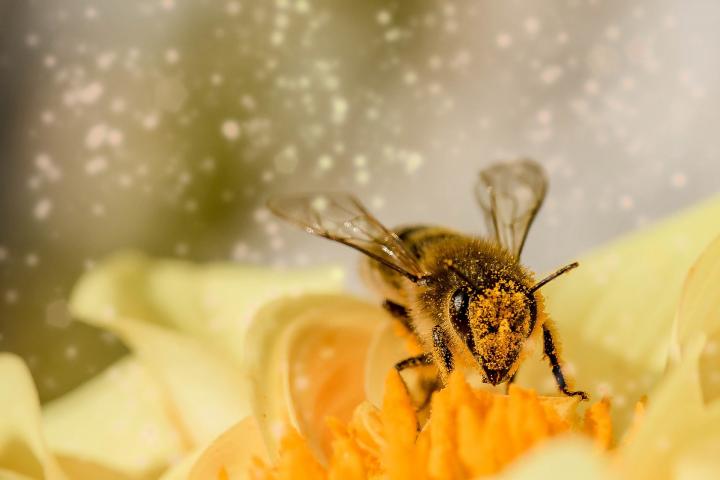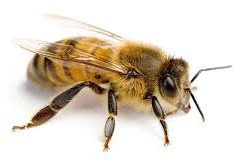Bee Control (Bees)
Get Free Quote
What are Bees?
Bees are flying insects closely related to wasps and ants, known for their role in pollination and, in the case of the best-known bee species, the European honeybee, for producing honey and beeswax. They belong to the superfamily Apoidea and are found on every continent except Antarctica, in every habitat on the planet that contains insect-pollinated flowering plants. Bees are distinguished by their capacity to store pollen and nectar, their complex social structures, and their sophisticated communication methods, including the famous “waggle dance” used by honeybees to convey information about food sources.
There are over 20,000 known species of bees, varying greatly in size, color, and behavior. Some bees are solitary, while others, like honeybees and bumblebees, are social, living in colonies with a single queen and numerous workers and drones. These social bees are critical to the environment and agriculture, as they pollinate plants and crops, facilitating the production of fruits, vegetables, and seeds. Bees’ pollination activities are crucial for the reproduction of many flowering plants, making them essential for biodiversity and ecosystem health.
Common Causes of Bees in SA
Availability of Food Sources
One of the primary reasons bees are attracted to homes and properties is the availability of food. Bees are drawn to sweet substances and flowering plants, which provide the nectar and pollen they need for survival. Gardens with blooming flowers, fruit trees, and even outdoor eating areas with sugary spills can attract bees. Additionally, improperly sealed food containers, exposed garbage bins, and compost heaps can serve as attractive food sources for bees.
Suitable Nesting Sites
Bees are constantly searching for suitable places to establish their nests. In South Africa, common nesting sites include wall cavities, attics, chimneys, and roof eaves. Structures with small openings or cracks can provide bees with access to sheltered areas where they can build their hives. Properties with abundant vegetation, such as thick hedges, shrubs, and trees, can also offer natural nesting sites for bees. Moreover, unused equipment, woodpiles, and other outdoor clutter can create perfect conditions for bees to establish a colony.
Weather Conditions
The warm climate in South Africa is conducive to bee activity. During the spring and summer months, when flowers are in full bloom and the weather is favorable, bees become more active in their search for food and nesting sites. This increased activity can lead to a higher likelihood of bees entering homes and properties. Additionally, during periods of drought or extreme heat, bees may seek out man-made structures for cooler, more protected environments.
Presence of Water Sources
Bees require water to regulate the temperature of their hives and to produce honey. Properties with accessible water sources, such as bird baths, swimming pools, leaky faucets, and pet water bowls, can attract bees. Ensuring that these water sources are properly managed or covered can help reduce the attractiveness of a property to bees.
Previous Bee Infestations
If a property has had a previous bee infestation, it may be more susceptible to future invasions. Bees often leave behind pheromones that can attract other bees to the same location. It is important to thoroughly remove any remnants of old hives and seal potential entry points to prevent recurring infestations.

Risks Associated with Bees
Bee infestations pose several risks, primarily related to the potential for bee stings and the structural damage caused by nesting. Bees, particularly Africanized honeybees (known as “killer bees”), can be aggressive when disturbed, posing a significant risk of multiple stings that may lead to allergic reactions or even anaphylactic shock in susceptible individuals. Beyond health risks, bees can also cause structural damage to homes and properties by nesting in wall voids, attics, or roof eaves, potentially leading to costly repairs. Moreover, the presence of bees can disrupt outdoor activities and affect the enjoyment of outdoor spaces, especially during peak bee activity periods. Managing bee infestations promptly and safely is crucial to mitigating these risks and ensuring the safety and comfort of residents and visitors alike.
Request A Free Quote
What are the steps to Bee Removal For Home or Office?

Removing bees from a home or office should be approached carefully and preferably by a professional to ensure the safety of both the occupants and the bees themselves. Here are the general steps involved in bee removal:
Identification and Assessment: First, identify the type of bee and assess the extent of the infestation. Determine whether they are honeybees or another species, as honeybees are typically relocated rather than exterminated due to their importance in pollination.
Contact a Professional: It’s advisable to contact a licensed bee removal specialist or pest control professional with experience in handling bees. They will have the necessary equipment, expertise, and knowledge of local regulations regarding bee removal.
Survey and Planning: The professional will conduct a survey of the property to locate the bee colony and assess the best approach for removal. This may involve inspecting wall voids, attics, roof eaves, or other potential nesting sites.
Safety Preparations: Prior to removal, ensure that all occupants, pets, and bystanders are safely away from the area. Bee removal can be hazardous due to potential stings, especially if dealing with aggressive bees or individuals with allergies.
Removal Techniques: Depending on the situation, the professional may use various techniques for bee removal. For honeybees, this typically involves gently removing the colony using specialized tools and equipment designed to minimize harm to the bees. Alternatively, for more aggressive species or in challenging locations, extermination may be necessary.
Repair and Prevention: After removal, any entry points or nesting sites should be sealed to prevent future infestations. Repair any structural damage caused by the bees, such as sealing holes or gaps in walls or roofs.
Environmental Considerations: If honeybees were removed, the professional may relocate them to a safer location or collaborate with local beekeepers for hive relocation. This supports bee conservation efforts and helps maintain local pollination services.
Monitoring and Follow-Up: Monitor the area after removal to ensure that all bees have been successfully removed and that no new colonies have formed. Follow any additional recommendations from the professional to prevent future bee problems.
By following these steps and working with a qualified professional, bee removal can be conducted safely and effectively, minimizing risks to both humans and bees while ensuring the preservation of these important pollinators.
Accend Solutions is Available 24/7 for Emergency Pest Control including Bee Control in all Gauteng and North-West Provinces in South Africa.
email: info@accend.co.za
call: 068 474 7303
FAQs on Bee Control
We know you may have questions about Bees in general and how Pest Control for Bees work. We have compiled a few FAQs on Bees that might clear the confusion.
CLICK HERE FOR FAQs ON BEES/ BEE CONTROL
Q. What types of bees are commonly found in South Africa?
South Africa is home to various bee species, but the most common include the African honeybee (Apis mellifera scutellata), European honeybee (Apis mellifera), carpenter bees (Xylocopa spp.), and bumblebees (Bombus spp.).
Q. Are bees dangerous?
While bees are generally beneficial pollinators, they can become aggressive when threatened or disturbed. Africanized honeybees, often referred to as “killer bees,” are known for their aggressive behavior and can pose a serious threat, especially to individuals with allergies.
Q. How can I differentiate between bees and wasps?
Bees are typically robust and hairy, while wasps have a slender body with less hair. Bees also have specialized pollen-collecting structures on their hind legs, called pollen baskets or corbiculae, which are absent in wasps.
Q. What should I do if I encounter a swarm or nest of bees?
Remain calm and slowly move away from the area. Do not swat at bees or make sudden movements, as this can agitate them. Contact a professional bee removal service immediately to assess the situation and safely remove the bees if necessary.
Q. How can I prevent bees from nesting on my property?
- Seal potential entry points such as cracks in walls, gaps in roof eaves, and holes in outdoor structures.
- Remove sources of standing water, as bees require water for their survival.
- Avoid planting bee-attracting flowers near entrances to buildings.
- Regularly inspect and maintain outdoor structures to prevent bees from establishing nests.
Q. What should I do if I discover a bee hive inside my home or office?
Do not attempt to remove the hive yourself. Contact a licensed bee removal specialist or pest control professional immediately. They have the expertise and equipment to safely remove the hive and relocate the bees if necessary.
Q. Are there eco-friendly methods for bee removal?
Yes, many bee removal specialists use eco-friendly methods such as hive relocation for honeybees. This involves safely removing the hive and relocating it to a suitable location where the bees can continue their pollination activities without posing a risk to humans.
Q. What are the legal implications of bee removal in South Africa?
In South Africa, honeybees are protected by law due to their importance in agriculture and pollination. It is illegal to harm or kill honeybees without proper authorization. Always ensure that any bee removal service you hire complies with local regulations and uses humane methods.
Q. How can I support bee conservation efforts?
- Plant bee-friendly gardens with a variety of native flowering plants.
- Avoid using pesticides and herbicides that can harm bees and other pollinators.
- Support local beekeepers and beekeeping initiatives in your community.
- Educate others about the importance of bees in our ecosystem and the threats they face.
Q. How can Accend Solutions help with bee control?
Accend Solutions offers professional bee removal services tailored to the specific needs of clients in South Africa. Our team of experts ensures safe and effective removal of bee hives while adhering to legal and environmental guidelines. Contact us for consultation and assistance with bee-related issues on your property.
These FAQs provide comprehensive information on bees and bee control in South Africa, addressing common concerns and offering guidance on responsible bee management practices.
